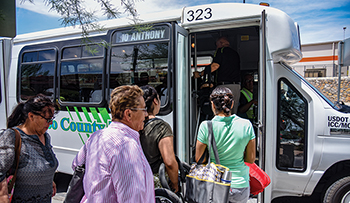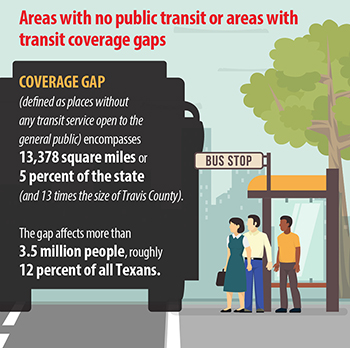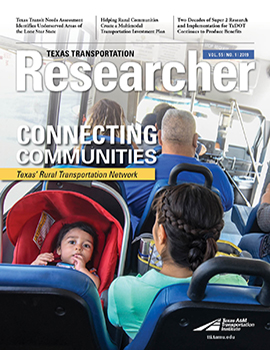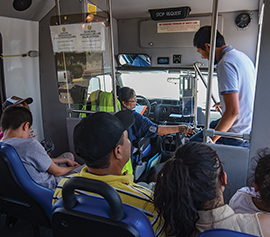Many Texans rely on public transit to go to work or school, keep medical appointments, shop and run errands, and travel to recreational activities.
In fact, in 2016, more than 30 million trips were made on Texas’ 67 transit systems (sometimes called districts) that receive state funding. Going to work was the most common trip purpose for those using urban transit, while medical appointments topped the list in rural transit districts.

A 2016 assessment performed for the Texas Department of Transportation (TxDOT) by the Texas A&M Transportation Institute (TTI) identified areas of Texas (outside of transit authorities) with limited or no public transit services. TTI researchers recently updated that assessment to better understand the gaps in public transit services statewide, noting not only where but also when service is not available.
The team, led by TTI Research Scientist Michael Walk, inventoried transit service areas that receive dedicated state funding, routes and time-of-day spans, identifying areas with no public transit or areas lacking service during certain hours. They found that the coverage gap (defined as places without any transit service open to the general public) encompasses 13,378 square miles or 5 percent of the state (and 13 times the size of Travis County). The gap affects more than 3.5 million people, roughly 12 percent of all Texans, a number surpassing the populations of Dallas, Fort Worth and Austin combined.
The assessment demonstrated that many people in Texas don’t have access to transit. It also showed that many people with access don’t have daily service that would meet a majority of trip purposes, including work, health care and personal errands.
“When service is too limited — eight hours per day, for instance — the service only works for a small proportion of the population whose current schedule fits into that window,” Walk explains.
Researchers stacked transit agencies’ service levels up against four different hours-of-service models to show what it would take to meet the hours of service in each model. Bringing all agencies up to those thresholds would require the following changes:
- 5 percent increase in operating hours for the 12-hour weekday service,
- 13 percent increase in hours for the 14-hour weekday service,
- 9 percent increase in hours for the 12-hour weekday/8-hour Saturday service, and
- 17 percent increase in hours for the 14-hour weekday/8-hour Saturday service.

The study also determined that the costs of reaching the higher service level thresholds would range from $46 million to $108 million per biennium. Research findings suggest significant economic benefits to the state from increased service levels.
“This research project informed and sharpened the focus of TxDOT’s request for additional state funding to improve access to public transportation in rural and smaller urban areas of Texas. TxDOT’s priorities include connectivity to jobs, shopping, education, medical care and other important destinations,” said Kelly Kirkland, business operations project manager in TxDOT’s Public Transportation Division.
Like most things, however, the cost of operating transit services is subject to inflation. While it would be simple to apply an existing measure like the Consumer Price Index (CPI) to peg those higher annual costs, the CPI doesn’t account for the complexities of public transit.
TTI researchers created a Transit Cost Index (TCI) to help agencies and departments of transportation forecast future increased operating costs. The TCI suggests that operating costs per revenue mile will increase for Texas transit agencies by up to 13 percent, depending on the type of service, by 2021 (compared to the base year of 2016).
“For transit systems to be useful, they must operate when and where service is needed, and must be funded to meet changing demands and costs,” Walk says. “That’s simple enough in theory but easier said than done. We believe the new Texas Transit Needs Assessment offers a clear and straightforward assessment of where transit needs are and the resources it will take to meet those needs.”
If additional funding can be secured, researchers can help TxDOT develop an implementation plan to assign dollars most effectively and realize widespread benefits as quickly as possible.
“Extended service would benefit current and potential riders, providing better mobility and independence,” Walk says. “Enhanced mobility benefits everyone — riders and non-riders, the community, businesses, and the state alike.”

